
Nacht und Traume
Photo Credit: Best Ever Media |
Nacht und Traume (2006)
Choreography by Peter Sparling
Nacht und Traume (Night and Dreams) - danced by a cast of six men to extraordinary Schubert liederis a hauntingly powerful portrayal of the human spirit rising out of confinement and captivity. An unseen door opens, and a man is hurled onto a black stage in a thin shaft of light. From a row of old metal bunk beds, a cast of weary survivors rolls forward to sweep the body up and back to safety. Six dances rise and fall with the music to propel the menand the constantly reconfigured arrangement of bunkstowards an inevitable ending. Was it all a dream, a nightmare?
|
| (No image available) |
Dances to Ives (2006)
Choreography by Peter Sparling & Jessica Fogel
Dances to Ives celebrates the most maverick of all American composers, Charles Ives. Set to a selection of songs, piano works and pieces for chamber orchestra, the medley of dances opens with a womens quartet to The Alcotts from Ives Concord Sonata, moves through colorful solos and trios, then closes with guest choreographers Jessica Fogels enigmatic, white-gloved figure dancing furtively to The Unanswered Question.
|
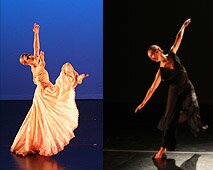
Handel Arias
Photo Credit: Best Ever Media |
PSDC/Solos: Handel Arias (2005)
Choreography by Peter Sparling
Handel Arias provides two dance divas with full-out performances combining high drama, sustained musicality and gorgeous form--emulating the operatic tradition of the show-stopping solo turn. Danced to Handels Ombra mai fu from Serse and Lascia chio pianga from Rinaldo, the companion solos hover in their own illuminated and emotionally charged worldssuspended against a black void.
|

Odes
Photo Credit: Best Ever Media |
PSDC/Solos: Odes (2005)
Choreography by Peter Sparling
Odes is danced archeology, the choreographers attempt to complete the puzzle left from the remaining fragments of the ancient Greek poet Sapphos enigmatic lyrics. Inspired by a translation by Anne Carson, the triptych of womens solos imagines in movement the linkage or connecting threads that bind together these passionate texts of love, loss and the hunger for beauty. Performed against Esther Kirshenbaums shimmering backdrop, Copper Waterfall, and to the turbulent, soulful music of Jesse Richards and Steve Mackey, three women dance their hearts out.
|

The End of Shame
Photo Credit: Best Ever Media |
PSDC/Solos: The End of Shame (2005)
Choreography by Peter Sparling
The End of Shame pits a man against his own image on video screen as he negotiates two conflicting aspects of his identity. The dynamic solo confronts contemporary issues of gender, sexual orientation and religion head-on. A testimonial voice-over alternates with pop favorites such as the disco hit, Shame, a ballad by Dusty Springfield and the gutsy hymn of happiness, Get Happy, sung by Judy Garland.
|

Peninsula
Photo Credit: Peter Smith |
Peninsula (2003)
Choreography by Peter Sparling
Peninsula Part II was supported in part by funding from MCACA. The complete version of Peninsula, including Part I: From Rust and Ruin, and Part III: Sounding the Glacier, will receive its premiere at the company's 10th Anniversary Season at the 2004 Ann Arbor Summer Festival. Special thanks to U-M Media Union, LS&A Media, Hartwick Pines State Park, Grand Traverse Lighthouse Museum, Woolsey Memorial Airport, Port Onieda Schoolhouse/Glen Lake Schools, Dunes National Lakeshore, Michigan Department of Transportation/Aviation, Bob and Joyce Bahle and Tim Sparling and Lynne Tobin.
One part of a performance trilogy celebrating the state of Michigan--its geography and natural splendor as well as its turbulent cultural and economic history-- Crossing the 45th Parallel features overlays of two danced landscapes. The two worlds-- one live on stage and one virtual on screen-- interface to provide a multi-faceted travelogue of sites and impressions of the Lower Peninsula along the 45th Parallel, halfway between the Equator and the North Pole.
|
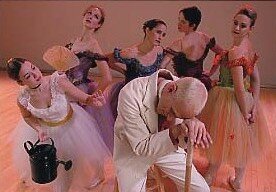
Les Parisiennes
Photo Credit: Peter Smith |
Les Parisiennes (2002)
Choreography by Peter Sparling
Music by Frederic Chopin: Nocturnes, performed by Artur Rubinstein
"
the Muses never talk among themselves
when they aren't working they dance." --Edgar Degas
Les Parisiennes was partially commissioned by the Detroit Institute of Arts in conjunction with its exhibition, "Degas and the Dance". It was also supported in part by funding from the Michigan Council for Arts and Cultural Affairs. Thanks to Julie Marsh and University Productions Costume Shop.
The inspiration for Les Parisiennes bridges Edgar Degas' numerous pastels of dancers in class or rehearsal with the more radical series of later compositions in vibrant, sometimes shocking yellows, oranges, pinks and greens. These solo portraits created on and for the company women -- to a selection of Chopin's elegant Nocturnes -- suggest the extravagance and backstage drama of an era in which female performers were held up as both objects of desire and vulnerable, often tragic heroines. Degas captured them in trenchant renderings of arrested motion and emotion.
|
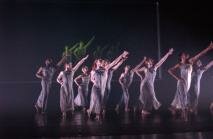
Patient Spider
Photo Credit: Peter Smith |
Patient Spider (2002)
Choreography and Concept by Peter Sparling
Music by J.S. Bach: Sonata No. 3 in C Major for Unaccompanied Violin
Lighting by Robert Murphy
Costumes by Jeff Bauer, courtesy of University Dance Company
Video Production by the UM Media Union: Tom Bray and Jacques Mersereau
Walt Whitman's poem, "A Noiseless Patient Spider", evokes a soul's yearning, ceaselessly venturing, "Till the bridge you will need be form'd, till the ductile anchor hold/Till the gossamer thread you fling catch somewhere, O my soul." Likewise, Bach's music for solo violin sets forth to weave a sonic architecture in space, evoking for the choreographer a tensile web of human movement and emotion and a floating window unto itslef. Suspended on this intricate web, a soul may cross with grace from yearning to jubilation.
|
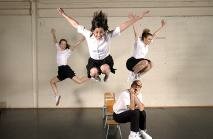
The Dossin Variations
Photo Credit: David Smith |
The Dossin Variations (2001)
Choreography and Costumes by Peter Sparling
Music by Frank Pahl and Klimperei: excerpts from "Music for Desserts"
Video by Terri Sarris
Set Design by Ronit Eisenbach
Lighting by Robert Murphy
This piece -- one of many versions -- is a response to the student days of artistic director Peter Sparling at Dossin Elementary School in Detroit. The work was originally created as part of the "Deroit 300: Artists Take on Detroit" exhibit at the Detroit Institute of Arts in the form of videotaped collages and projections by Terri Sarris as part of an installation piece with architectural design by Ronit Eisenbach.
|
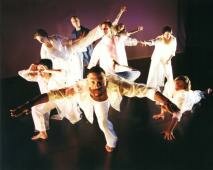
Possible Dances
Photo Credit: David Smith |
Possible Dances (2000)
Choreography, text, and costumes by Peter Sparling
Sound score by Paul Epstein
21 minutes
Poetic imagery comes into life in Peter Sparling's work Possible Dances. Set to six of Sparling's own poems, the dance is performed by the choreographer and seven dancers proceeding through the landscape of the spoken word. Poems of instruction, friendship, mourning, love, extraordinary occurrences, and finally a modern day psalm become vividly danced statements about what it means to create and live our daily metaphors. Sparling's collaborator of 30 years, New York composer Paul Epstein, provides a sound score which transforms the text into melody and vocal soundscapes.
|

Traffic!
Photo Credit: David Smith |
Traffic! (2000)
Choreography by Julianne O'Brien Pedersen, Lisa Catrett-Belrose, Tim Smola
Music by Edie Herrold
Costumes by Nephelie Andonyadis
30 minutes (approx.)
Traffic! celebrates invention of the traffic light in Detroit in 1928. PSDC dancers take a leap of the imagination into the worlds of GREEN, YELLOW and RED. Traffic! unfolds through a series of urban and rural landscapes, evoked by human responses to the commands GO, YIELD or STOP. Traffic! weaves dancers into a delightful, dangerous, and provocative web of movement patterns and mini-dramas.
|
| (No image available) |
Kiss the Joy as it Flies (2000)
Choreography and costumes by Peter Sparling
Music by W. A. Mozart: Divertimento in F, KV 138: Andante and Presto
Text by Bernie and Dottie Coyne
25 minutes
In this moving tribute to love and commitment, documentary-style text is woven through the movement of the dancers to provide a narrative score incorporating segments of Mozart divertimentos.
|
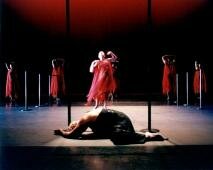
Orfeo Suite - Dance of the Furies
Photo Credit: Dale Dong |
Orfeo Suite (1999)
Choreography by Peter Sparling
Music by Christophe Willibald Gluck: Dance of the Furies, Dance of the Blessed Spirits
Costumes by Nephelie Andonyadis
Lighting by Jonathan Belcher
15 minutes
The suite of excerpts offers three selections from a full-length production of the opera. The Greek legend tells of Orfeo's decent into Hades to recover his wife, Euridice, by placating the gods with the sound of his music. At the close of Act I, a brief prelude reveals Orfeo approaching a cave beyond the river Styx. Moved and provoked by Orfeo's grief, the Furies open Hades' portals to him and dance themselves into a frenzy. At the opening of Act II, Euridice is discovered in a flowery glade of the Elysian fields - her refuge in the underworld - and is joined by the Blessed Spirits in a dance of tranquil forgetfulness.
|

Chronicles and Small Comforts
Photo Credit: David Smith |
Chronicles and Small Comforts (1998)
Choreography by Peter Sparling
Music by William Bolcom: Twelve New Etudes (1988 Pulitzer Prize Winner)
Costumes by Nephelie Andonyadis
Lighting by Jonathan Belcher
Chronicles and Small Comforts celebrates the musical score's infinite variety of musical texture and coloration as well as its humanistic evocations by suggesting a time, a place, and a gathering of people. A small town community, as seen through the eyes of its somewhat self-righteous librarian/historian, takes on a timeless, archetypal dimension, embracing a cast of characters whose inner and outer lives intersect, collide, and coalesce. Inspired by and following the twelve-part form of the music, a series of interior and exterior scenes unfold -- from a town hall lecture to more intimate encounters -- culminating in a hymn proclaiming the librarian's transcendent vision.
|
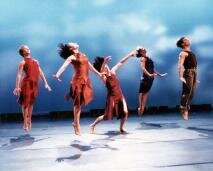
Port
Photo Credit: David Smith |
Port (1998)
Choreography by Julianne O'Brien Pedersen
Music by Steve Reich, Pat Metheny and Edie Herrold
Costumes by Erika Furey and Matt Mitchell
17 minutes
Port potrays a community of dancers in three spaces. The first landscape is one of expanse, meant to be travelled in, marked, shared, and encompassed. The second geography is a more intimate landscape between two people, etching and mapping a new place and accumulated space together. The final section examines how the family of dancers readjusts to a changed inner and outer landscape.
|
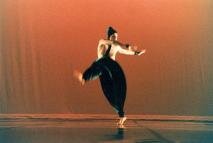
Jealousy
Photo Credit: David Smith |
Jealousy (1992)
Choreography by Peter Sparling
Music by Alfred Schnittke: Hymns for Chamber Ensemble (No.3 and 4)
Costume by John Gutoskey
The two-part solo expresses in sculpted and contorted motion the emotional extremes of envy and jealousy. As a gargoyle or possessed creature come to life, the dancer unfurls a rapid-fire series of epithets and exhortations, displaying the agony and strange pleasure of roasting in his own private hell. Only at the tunnel's end is there the faint glimmer of hope or redemption.
|
